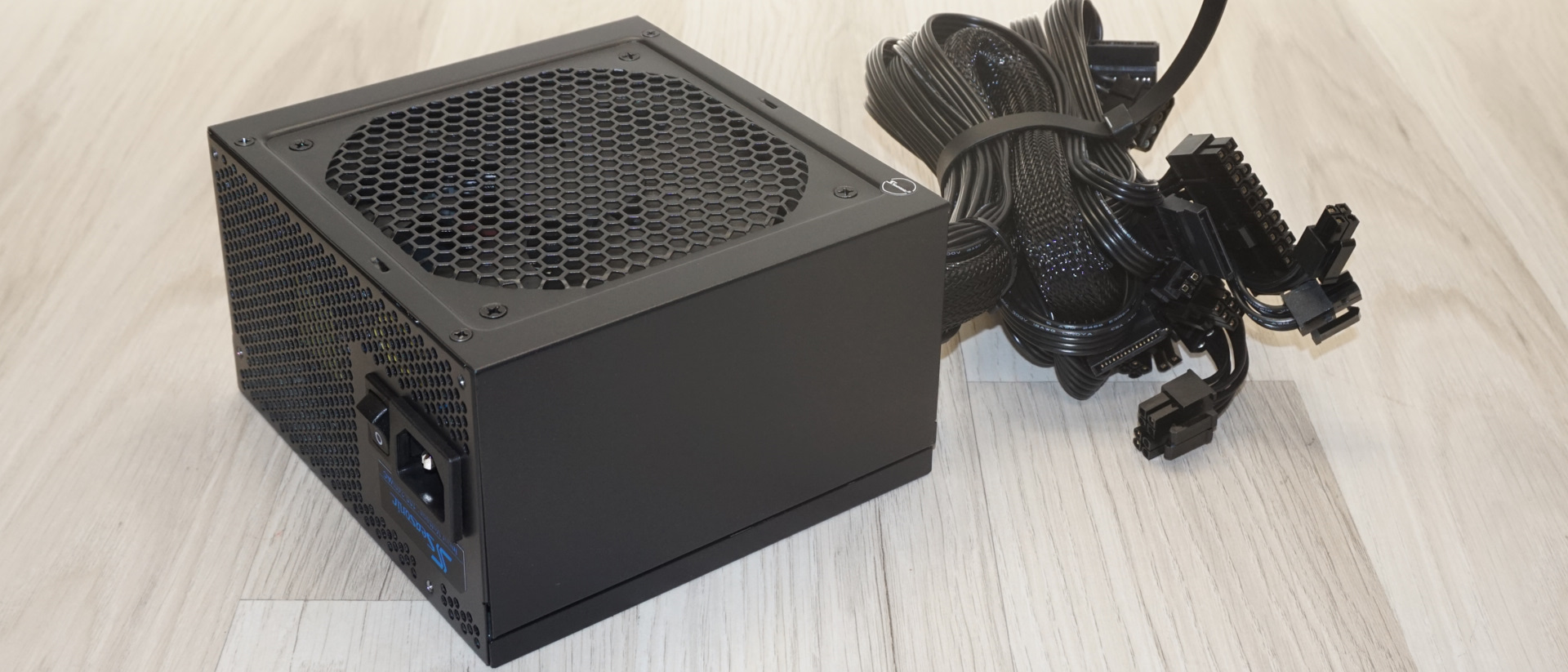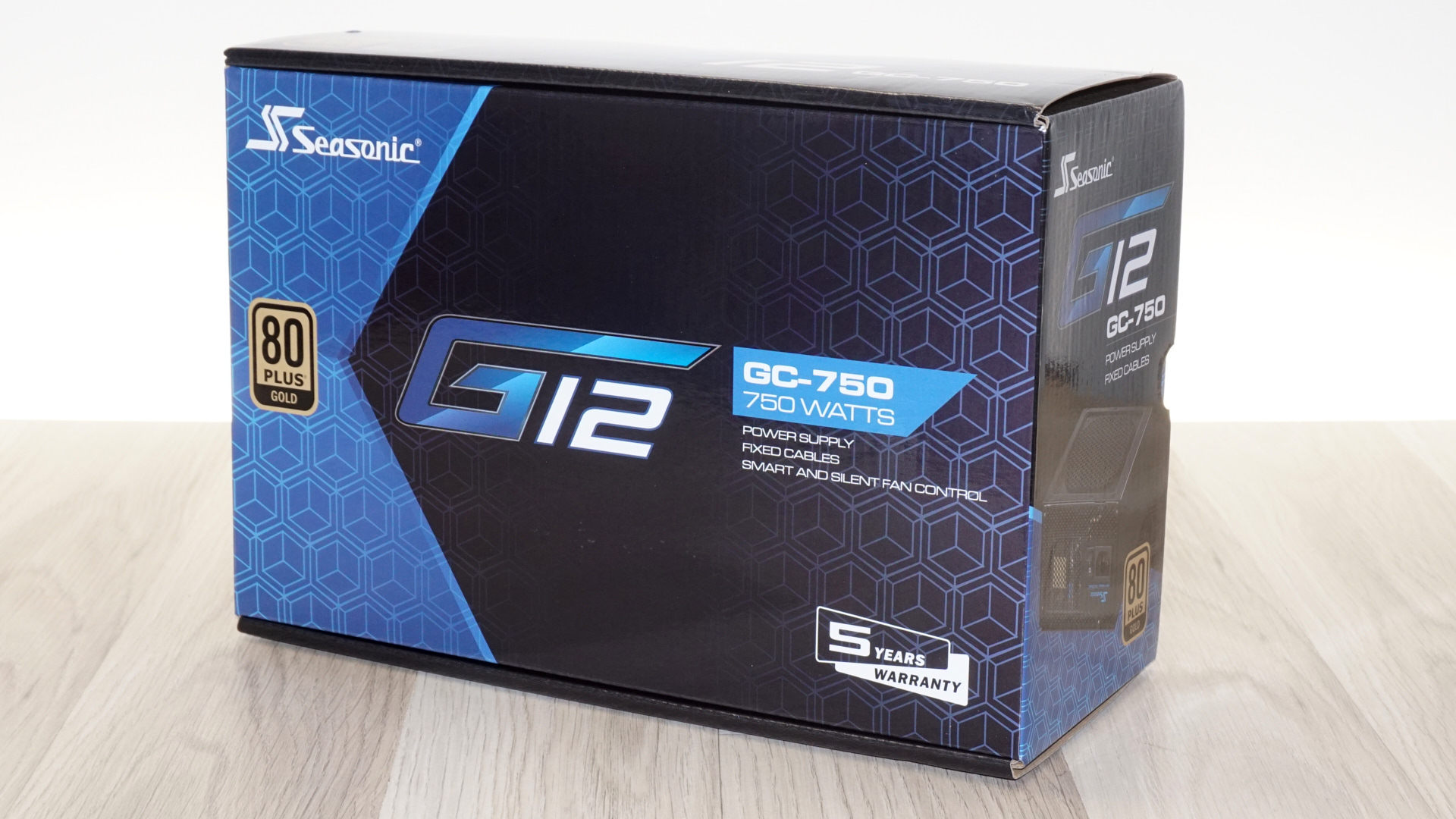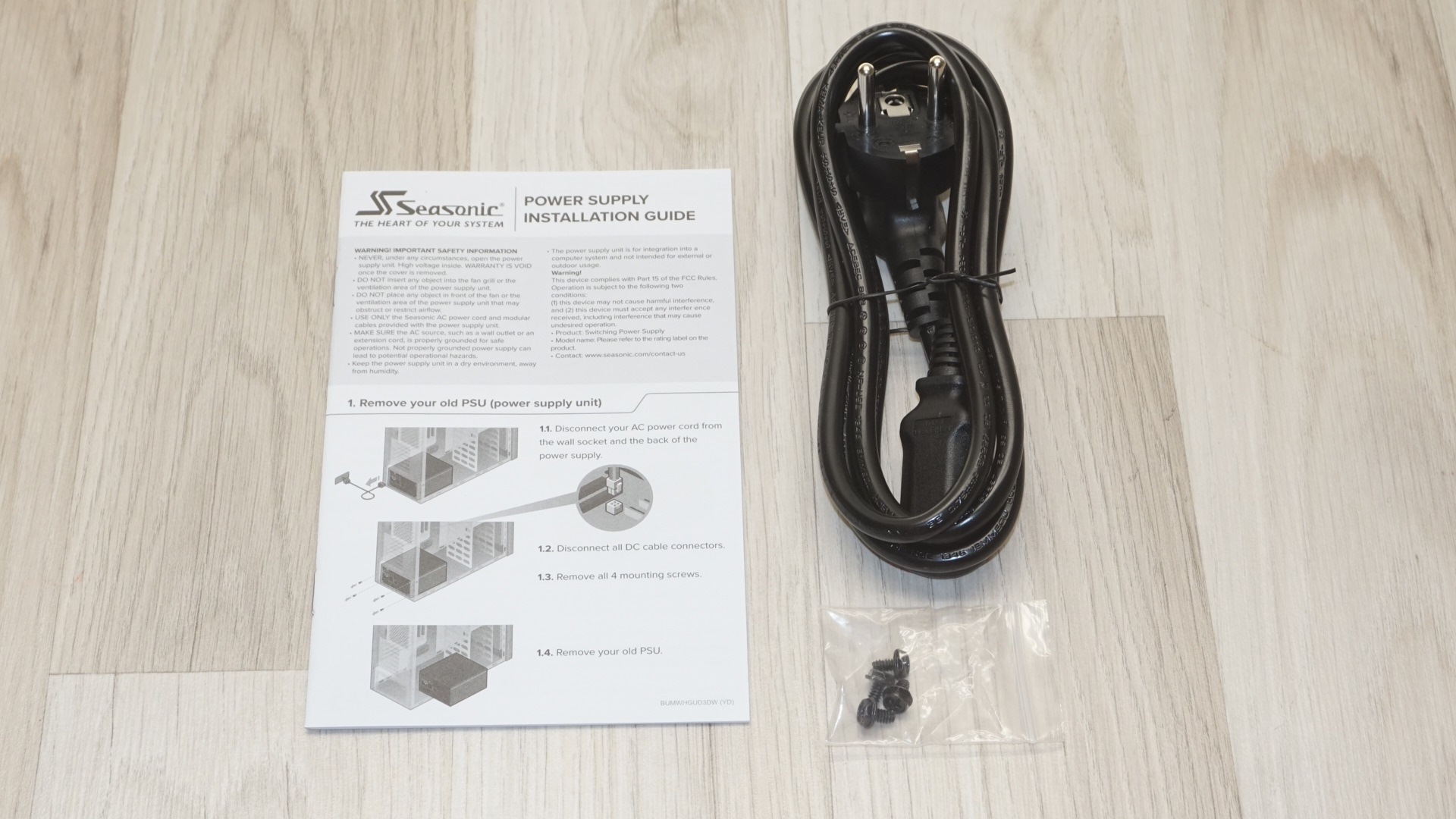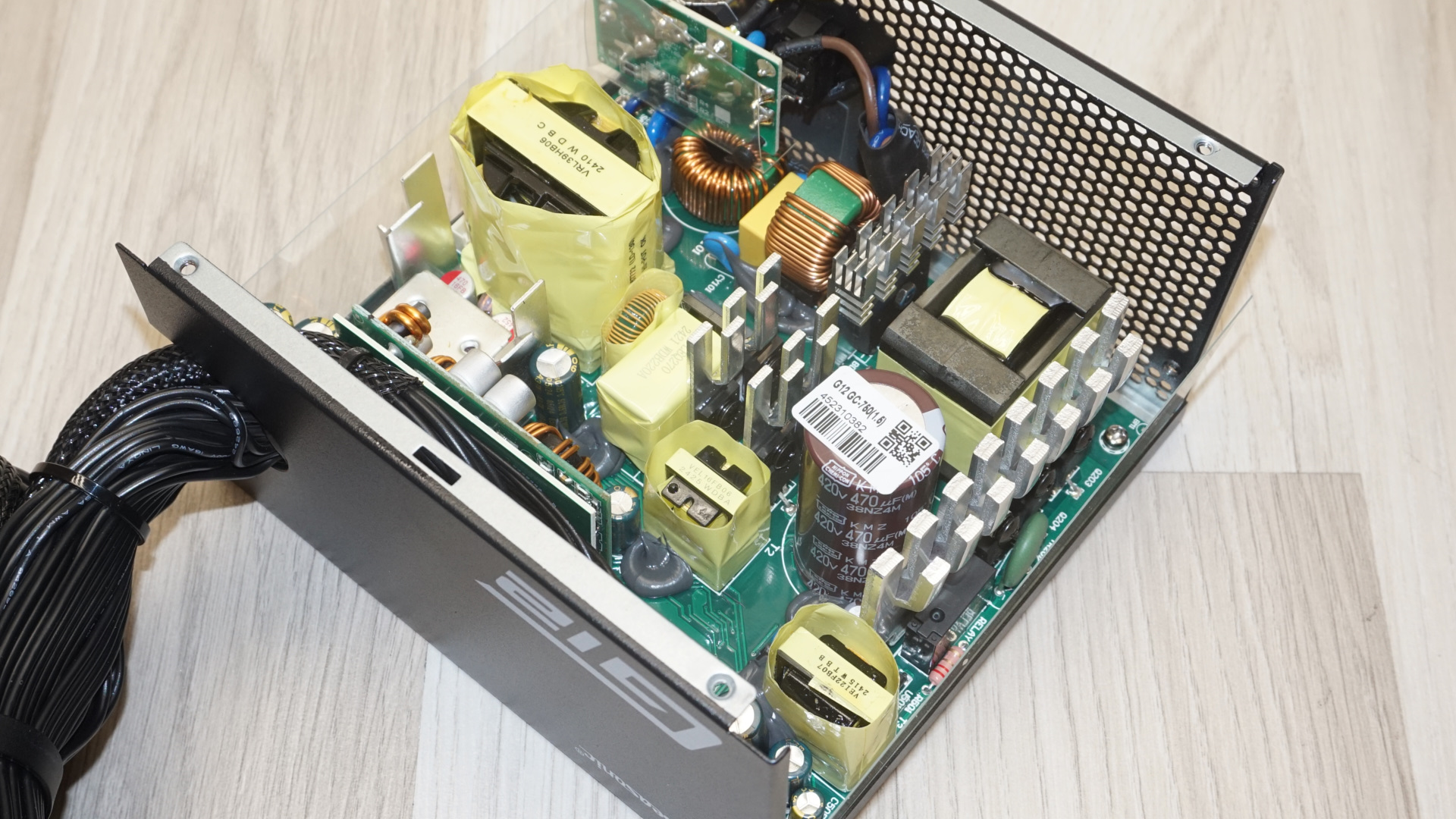Tom's Hardware Verdict
The Seasonic G12 GC-750 represents a fascinating paradox in power supply design, an internally sophisticated unit hobbled by external compromises. Built on a proven platform that has powered numerous high-end products, this unit delivers electrical performance and component quality that rival top-tier solutions. However, the non-modular cable design, absence of modern PCIe 5.0 connectivity, and retail pricing position it awkwardly against more feature-rich competitors. When found on sale, it transforms into an outstanding choice for reliability-focused builders. At full MSRP, it struggles to justify its premium.
Pros
- +
Compact 140mm depth
- +
80 Plus Gold
- +
Exceptional electrical performance
- +
Outstanding voltage regulation
- +
Top-tier component selection
- +
Good low-load efficiency
Cons
- -
Non-modular cable configuration
- -
No 12V-2x6 connector
- -
Retail pricing
- -
Aggressive fan profile
Why you can trust Tom's Hardware
Seasonic has long occupied a unique position in the power supply industry as one of the few manufacturers that designs, engineers, and produces its own units rather than relying on third-party ODMs. This vertical integration allows the Taiwan-based company to maintain exceptional quality control while building decades of platform development expertise. The Seasonic name has become virtually synonymous with reliability in enthusiast circles, though this reputation commands premium pricing that can make their products difficult to recommend in intensely competitive market segments.
The G12 GC-750 enters this challenging landscape with an unusual strategy. Rather than developing an entirely new budget-oriented platform, Seasonic has repurposed a proven design that has underpinned several high-end products over the past five years. This approach promises exceptional engineering fundamentals typically reserved for premium units, theoretically allowing Seasonic to compete on quality rather than features. The unit adheres to the Intel ATX 12V v2.31 specification and achieves 80 Plus Gold certification, targeting the mainstream market while maintaining Seasonic's characteristic focus on long-term reliability. At its typical retail price exceeding $140, however, the G12 GC-750 faces formidable competition from both Seasonic's own product line and rivals offering modular designs with contemporary connectivity. This positioning creates an intriguing question: can exceptional internal quality overcome external compromises in today's feature-driven market? We take a close look at the G12 GC-750 to determine whether it belongs on our best power supplies list.
Specifications and Design
RAIL | +3.3V | +5V | +12V | +5Vsb | -12V |
MAX OUTPUT | 20A | 20A | 62A | 3A | 0.3A |
| Row 2 - Cell 0 | 100W | 100W | 744W | 15W | 3.6W |
TOTAL | 750W | Row 3 - Cell 2 | Row 3 - Cell 3 | Row 3 - Cell 4 | Row 3 - Cell 5 |
AC INPUT | 100 - 240 VAC, 50 - 60 Hz | Row 4 - Cell 2 | Row 4 - Cell 3 | Row 4 - Cell 4 | Row 4 - Cell 5 |
MSRP | $100 | Row 5 - Cell 2 | Row 5 - Cell 3 | Row 5 - Cell 4 | Row 5 - Cell 5 |
*100% capacity at 40 °C, 80% capacity at 50 °C
In the Box
The Seasonic G12 GC-750 arrives in packaging that reflects the unit's split personality between premium engineering and budget positioning. The cardboard box features a black and blue aesthetic theme, with the G12 GC series logo dominating the front panel while smaller product images occupy the sides. Inside, foam inserts and a nylon pouch that cradle the unit during transport provide additional protection.
The accessory bundle strips away any pretense of premium treatment. Seasonic includes only the bare essentials: mounting screws and a standard AC power cable. There are no cable management accessories, no documentation beyond basic specifications, and none of the extras that we would expect bundled with a premium unit.
The cable situation warrants significant discussion, as it represents one of the G12 GC-750's most controversial design decisions. Every cable emerges hardwired from the unit's chassis, a design philosophy that has become increasingly rare in an era where even budget power supplies typically offer at least partial modularity. Seasonic also offers the G12 GM series, a semi-modular version of these units for a slightly higher price. Most significantly, the G12 GC-750 completely omits a 12V-2x6 connector, immediately limiting compatibility with graphics cards requiring one. Given the unit's 750W capacity and the proven platform's ability to handle high-end components, this absence appears to be a product age issue rather than a technical limitation. For builders planning to use current-generation high-end graphics cards or for users planning on frequent future upgrades, this represents a deal-breaking omission. Seasonic employs all-black cables throughout, with most featuring flat, ribbon-like construction devoid of exterior sleeving. The ATX cable receives special treatment with black nylon sleeving, while a substantial reusable cable strap keeps the bundle organized.
Connector type | Hardwired | Modular |
|---|---|---|
ATX 24 Pin | 1 | - |
EPS 4+4 Pin | 2 | - |
EPS 8 Pin | - | - |
PCI-E 5.0 | - | - |
PCI-E 8 Pin | 3 | - |
SATA | 6 | - |
Molex | 3 | - |
Floppy | - | - |
External Appearance
Seasonic's design philosophy more frequently than not emphasizes elegant simplicity over aggressive styling, and the G12 GC-750 exemplifies this approach beautifully. The unit receives a satin black chassis finish that demonstrates exceptional quality, resisting fingerprint marks and scratching. The chassis adheres precisely to the ATX standard's 140mm length specification, ensuring universal compatibility with any ATX-compliant case without clearance concerns.
Get Tom's Hardware's best news and in-depth reviews, straight to your inbox.

The front panel is home to just a typical AC cable receptacle and an on/off switch, complemented by subtle Seasonic branding. The rear panel, dictated by the fully hardwired cable design, presents a plain surface that is adorned with the series logo. The right side of the unit displays the electrical specifications and certifications sticker, providing essential information without cluttering the overall aesthetic.
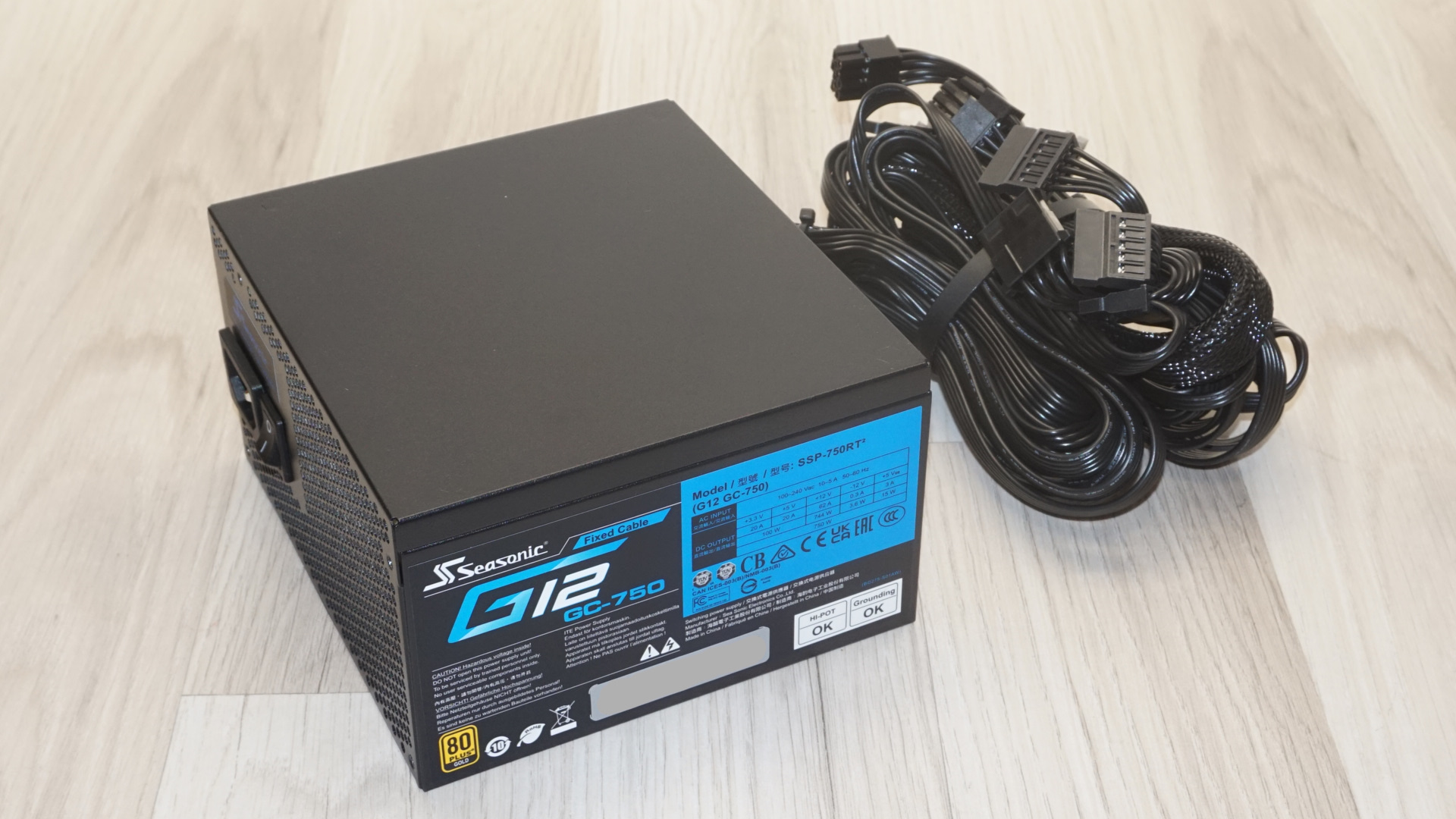
The top surface features a honeycomb-pattern fan finger guard that integrates seamlessly with the chassis. It is very dense and there is no logo standing out. This design provides effective airflow characteristics while maintaining the unit's clean, professional appearance. The overall presentation strikes a balance between functionality and understated elegance that should complement virtually any build without drawing attention to itself.
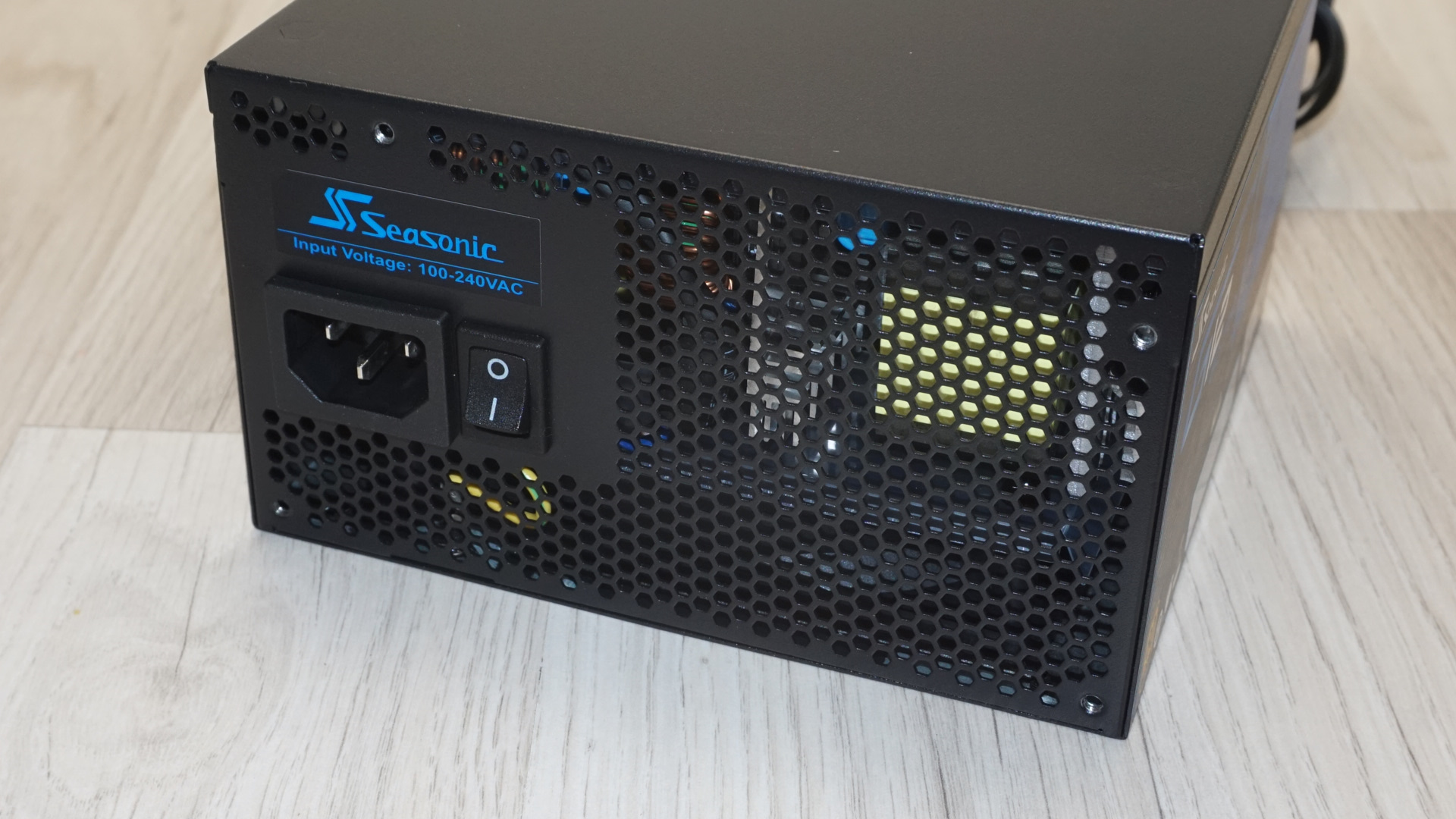
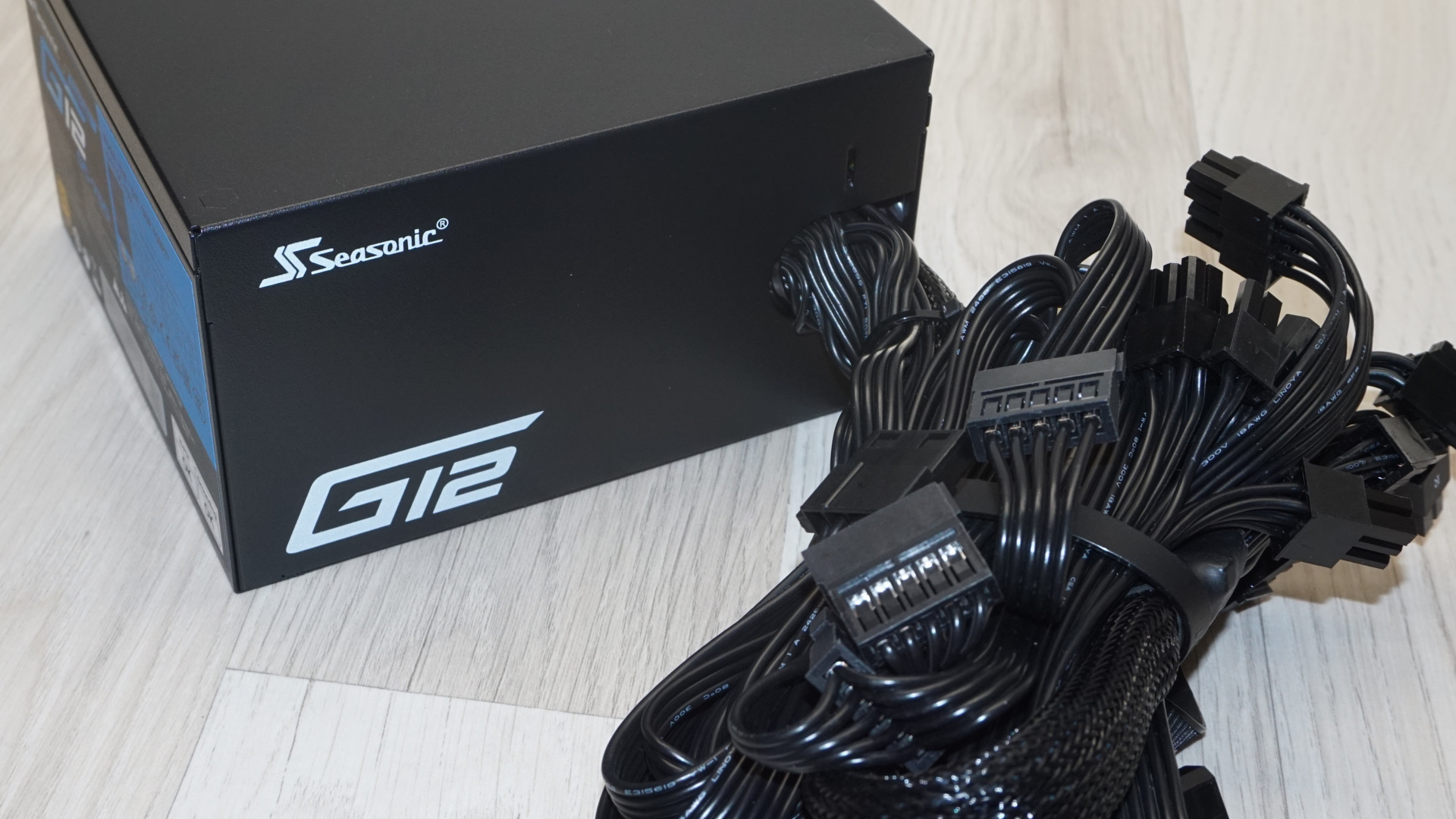
Internal Design
A Hong Hua HA1225H12F-Z 120mm fan equipped with a fluid dynamic bearing (FDB) engine is responsible for the cooling of this unit. This represents a significant step up from the basic sleeve-based alternatives typically found in budget-oriented units. FDB fans offer exceptional reliability and remarkably quiet operation, with premium pricing being virtually their own practical drawback. The maximum rotational speed of 2200 RPM seems very aggressive for a 750W unit.
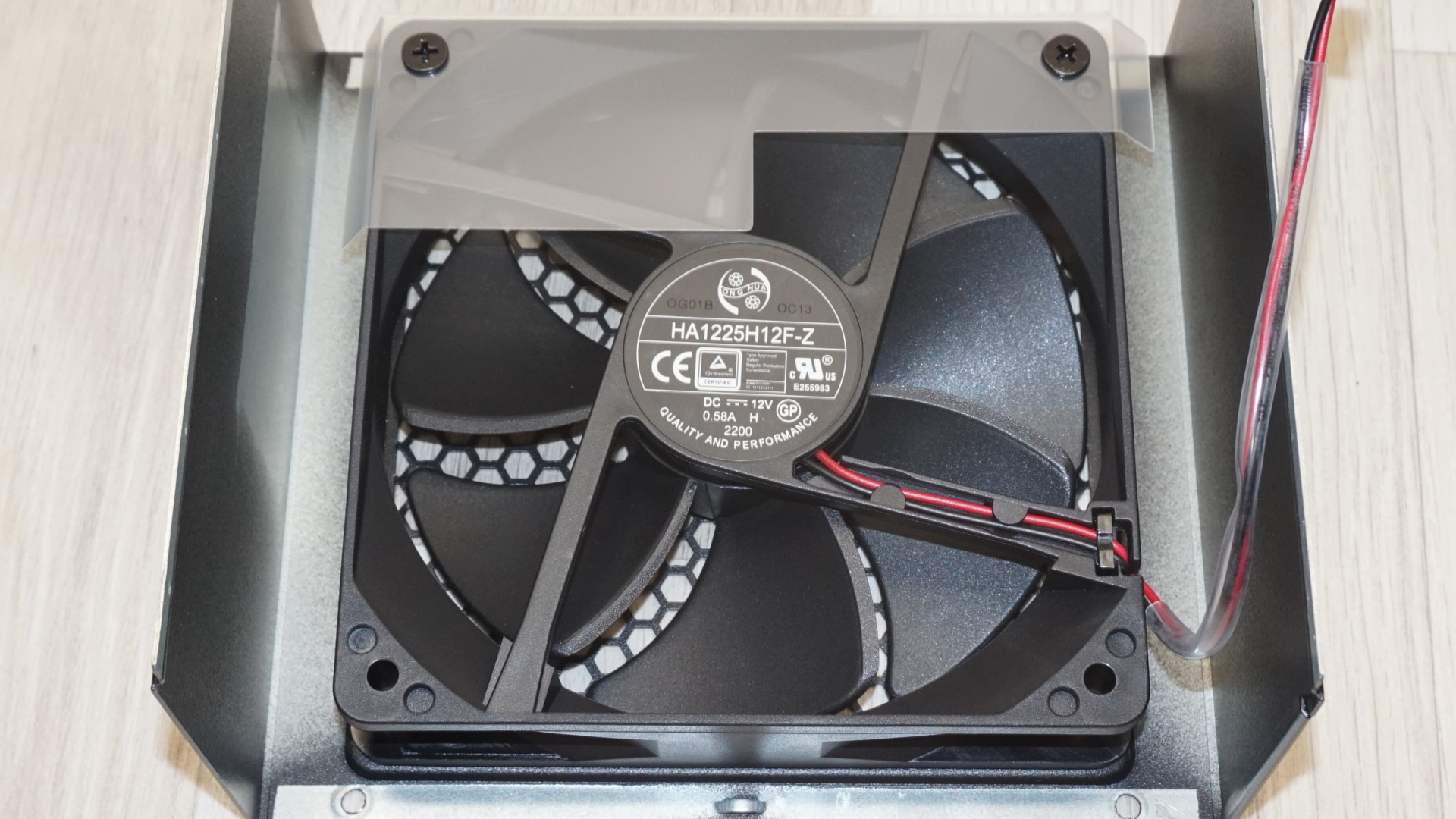
As expected from Seasonic, the G12 GC-750 eschews third-party ODM platforms entirely. Seasonic designed and manufactured this unit in-house, drawing upon the company's extensive platform development experience. The use of a proven design that has powered numerous high-end products over the past five years immediately signals that the G12 GC-750 benefits from mature engineering.
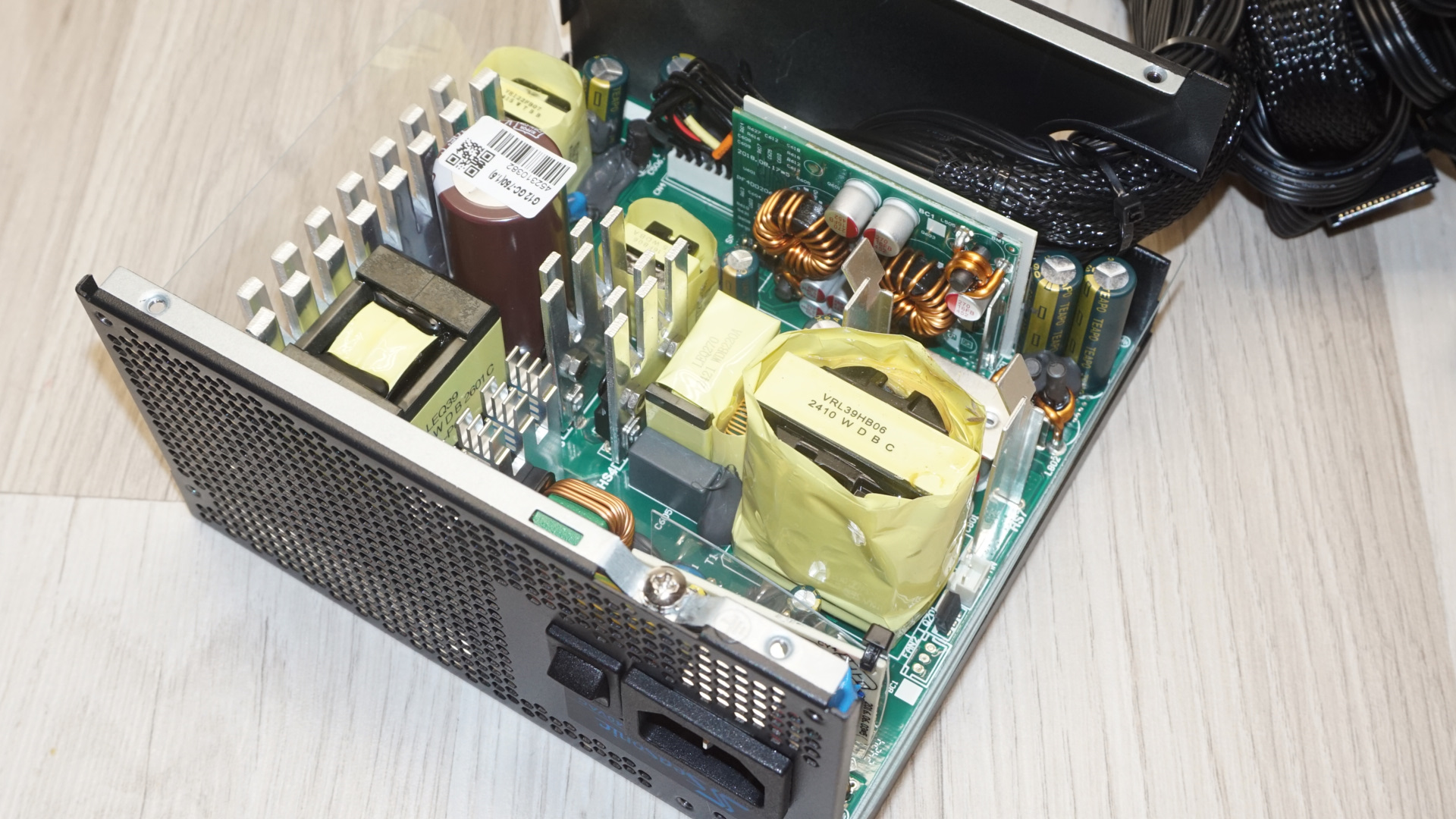
The input filtering stage implements a fairly strong configuration utilizing four Y capacitors, two X capacitors, and two filtering inductors. Two rectifying bridges are mounted on a substantial shared heatsink positioned immediately after the filtration stage. The APFC circuitry demonstrates Seasonic's willingness to invest in quality components despite the unit's budget positioning. Two Infineon 60R180P7S MOSFETs handle active power factor correction alongside a single STMicroelectronics diode, paired with an encased inductor and a premium Nippon Chemi-Con 470 μF capacitor.
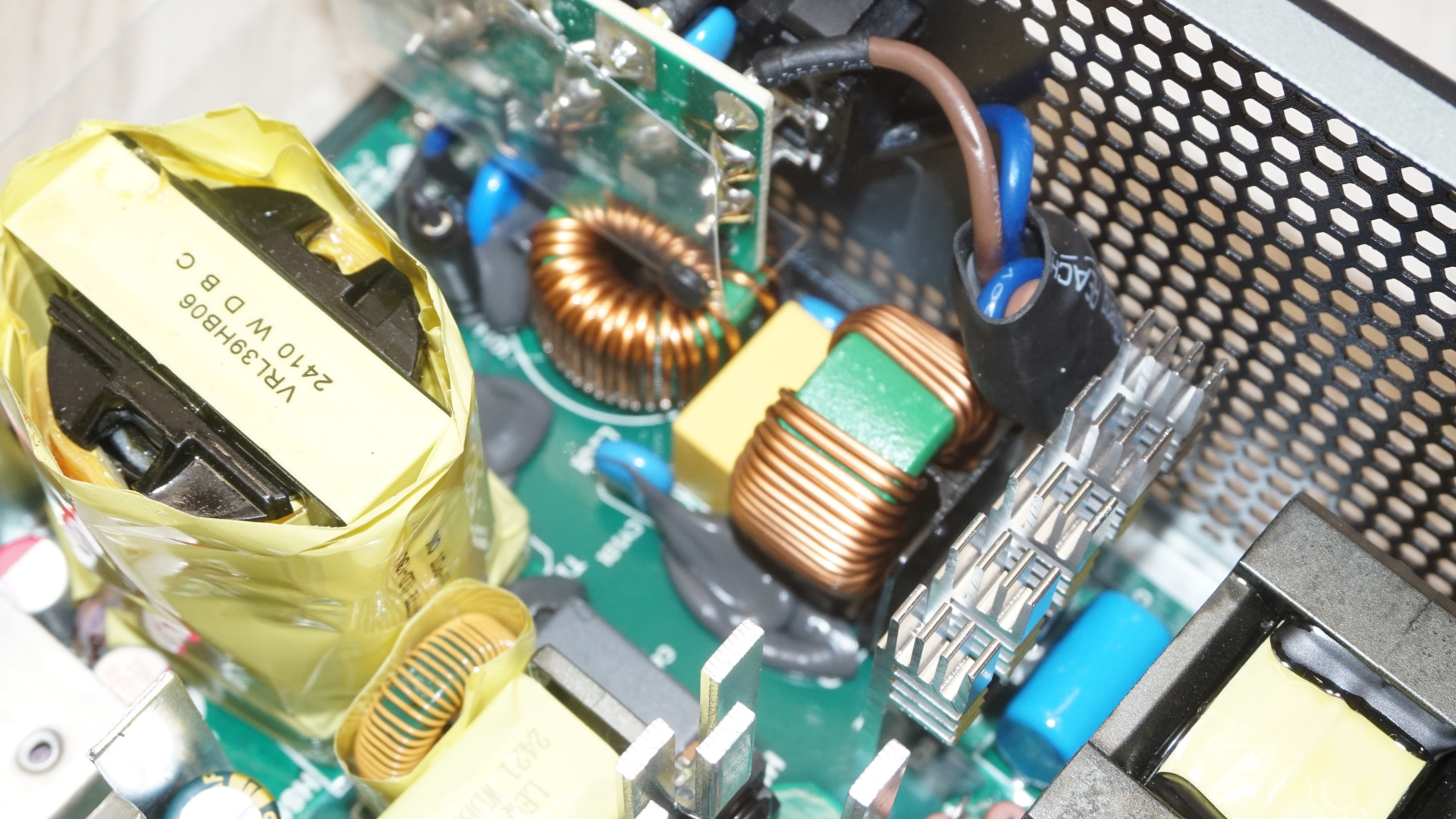
The primary inversion stage employs four Great Power GPT10N50AD MOSFETs arranged in a full-bridge topology configuration. This design choice merits discussion, as full-bridge topologies typically appear in higher-end units rather than budget-focused designs. Rather than utilizing two expensive high-performance MOSFETs in a half-bridge configuration, Seasonic opted for four mainstream components that collectively deliver comparable performance while potentially offering better thermal characteristics through load distribution. These MOSFETs mount on two dedicated heatsinks in pairs, ensuring adequate cooling even under sustained high-load conditions.
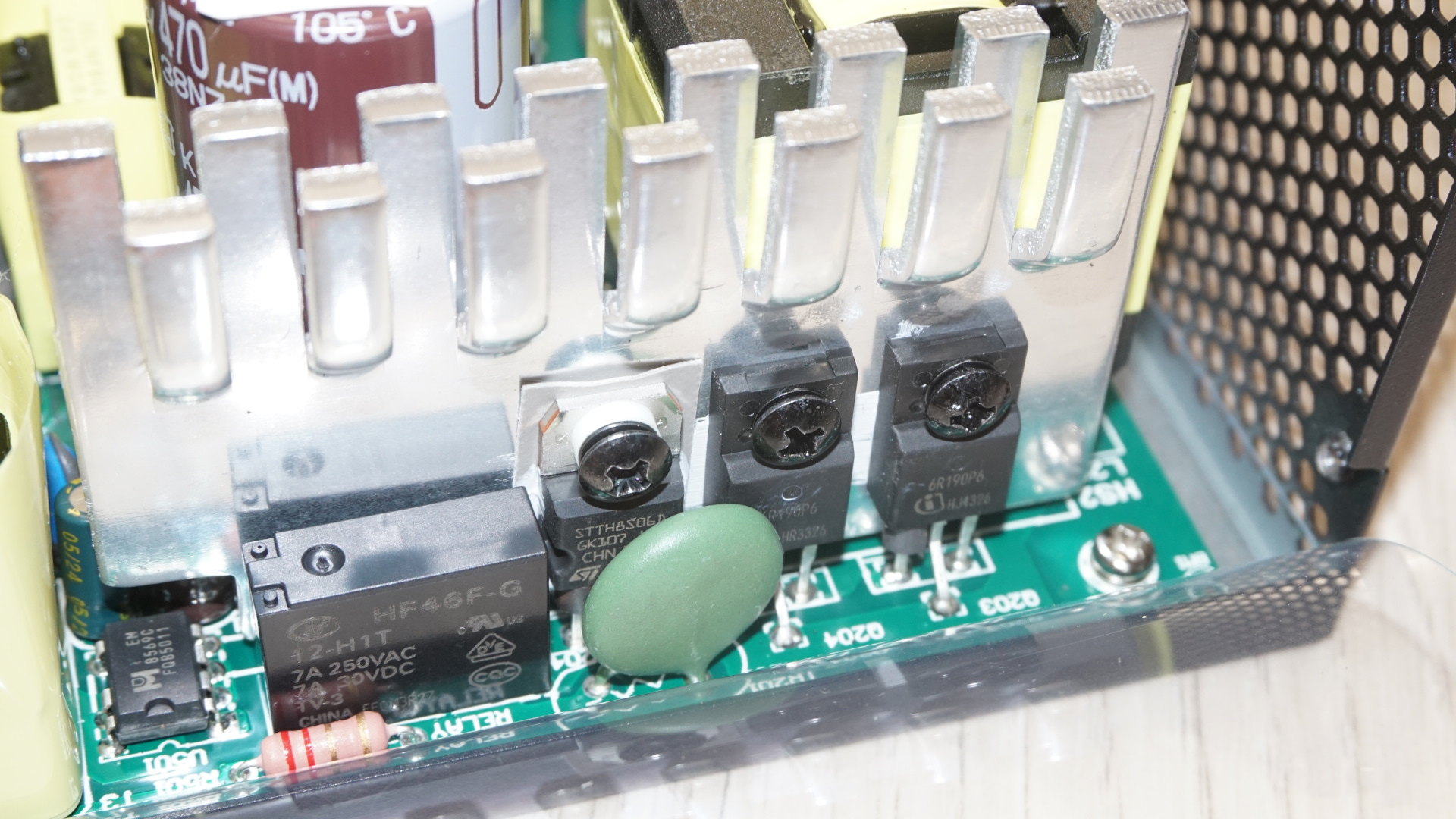
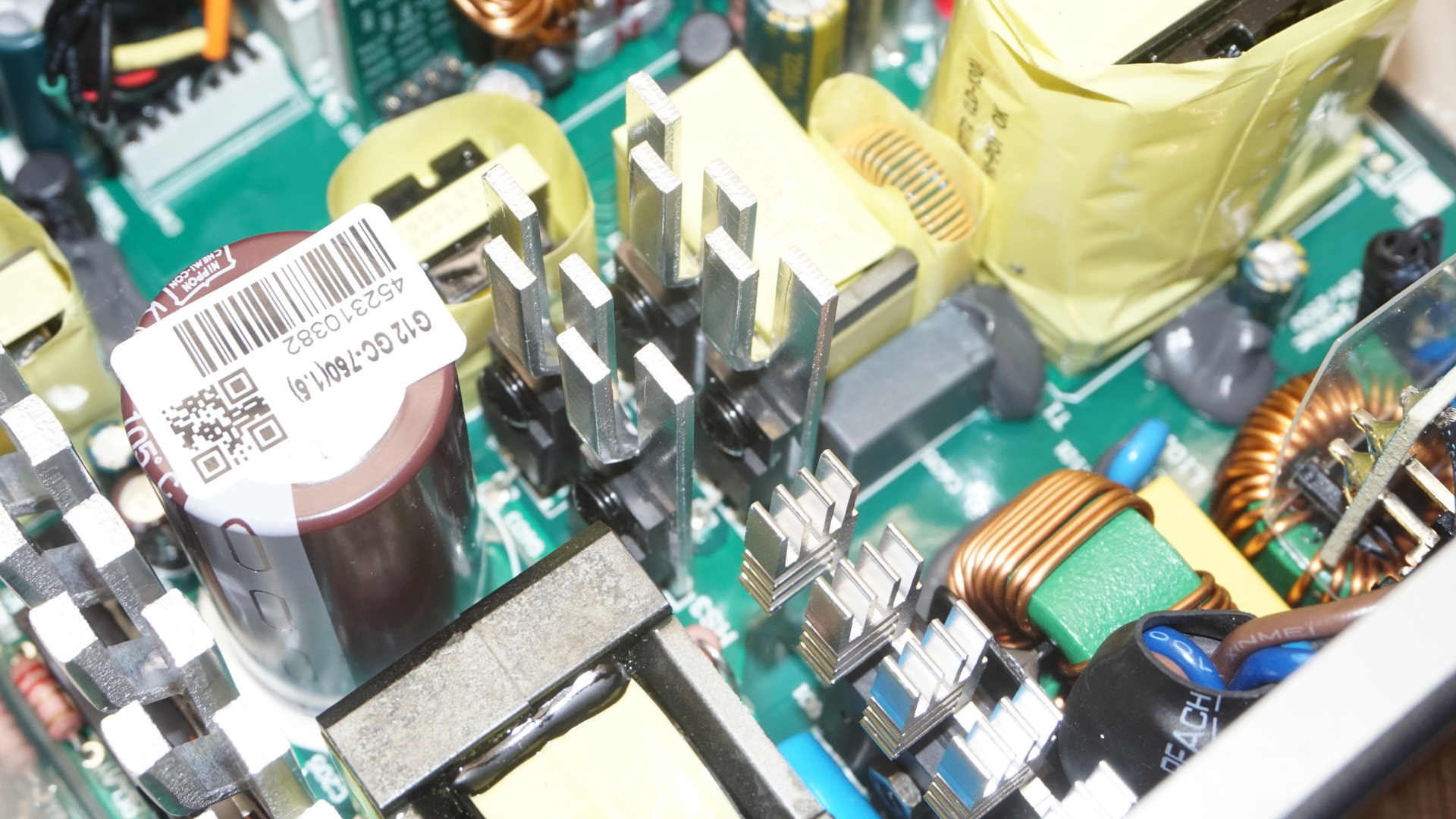
The secondary side implementation places synchronous rectification MOSFETs underneath the main PCB. Four Nexperia units handle the primary 12V rail generation through standard synchronous rectification assembly. Separate DC-to-DC circuits on a vertical daughterboard generate the 3.3V and 5V rails.
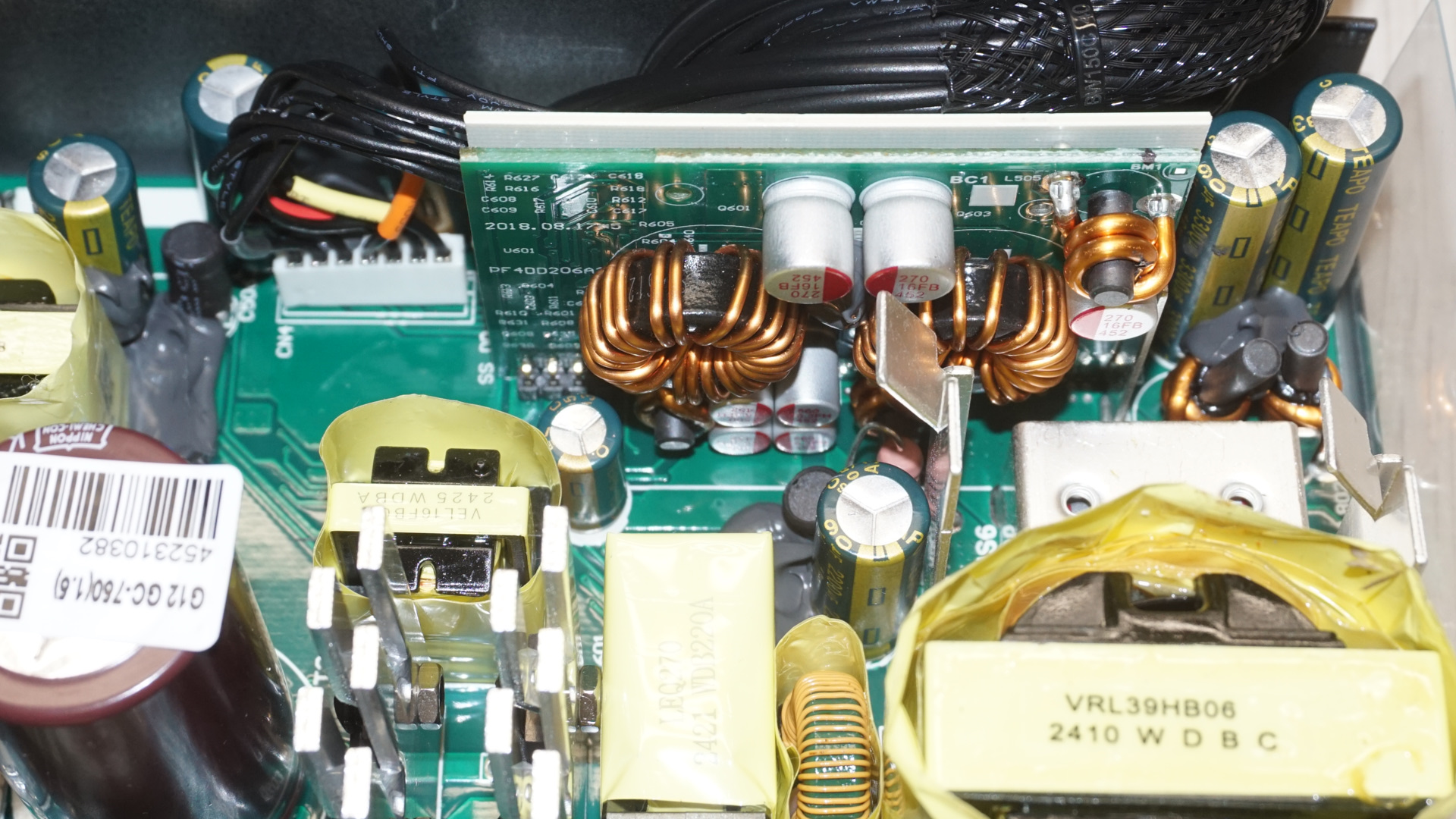
The capacitor selection throughout the secondary side comes exclusively from Teapo, a highly reputable Taiwanese manufacturer whose products occupy a respected position in the component hierarchy. While Teapo capacitors may not command the same reverence as flagship Japanese alternatives from manufacturers like Nippon Chemi-Con or Rubycon, they represent excellent choices for mainstream retail products and far exceed the specifications of budget-tier alternatives. An interesting construction detail: rather than direct PCB soldering, the wires connect through some sort of crimped wire end terminals that are then soldered to the board, with a plastic assembly grouping them.
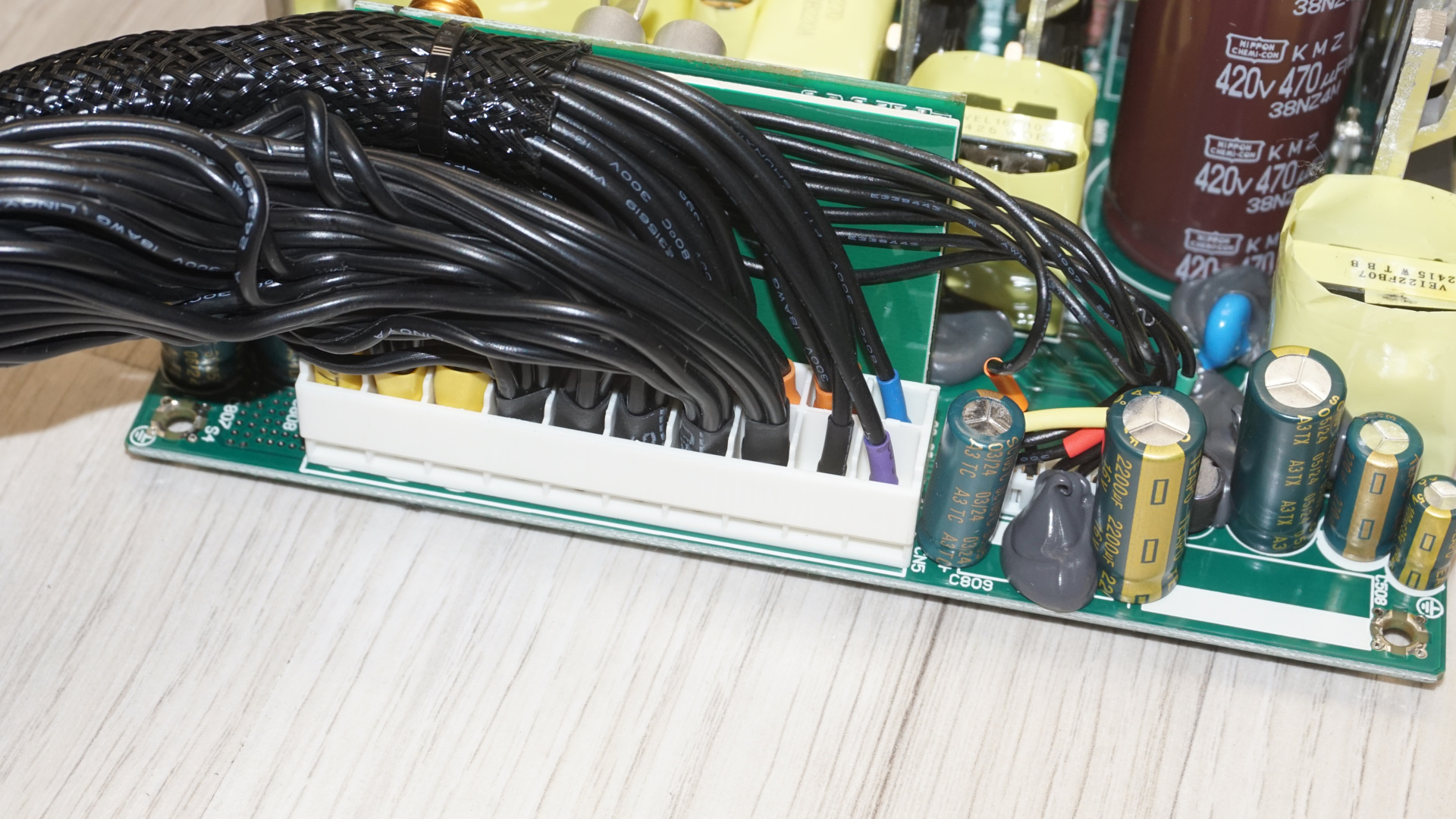
Cold Test Results
Cold Test Results (25°C Ambient)
For the testing of PSUs, we are using high precision electronic loads with a maximum power draw of 2700 Watts, a Rigol DS5042M 40 MHz oscilloscope, an Extech 380803 power analyzer, two high precision UNI-T UT-325 digital thermometers, an Extech HD600 SPL meter, a self-designed hotbox and various other bits and parts.
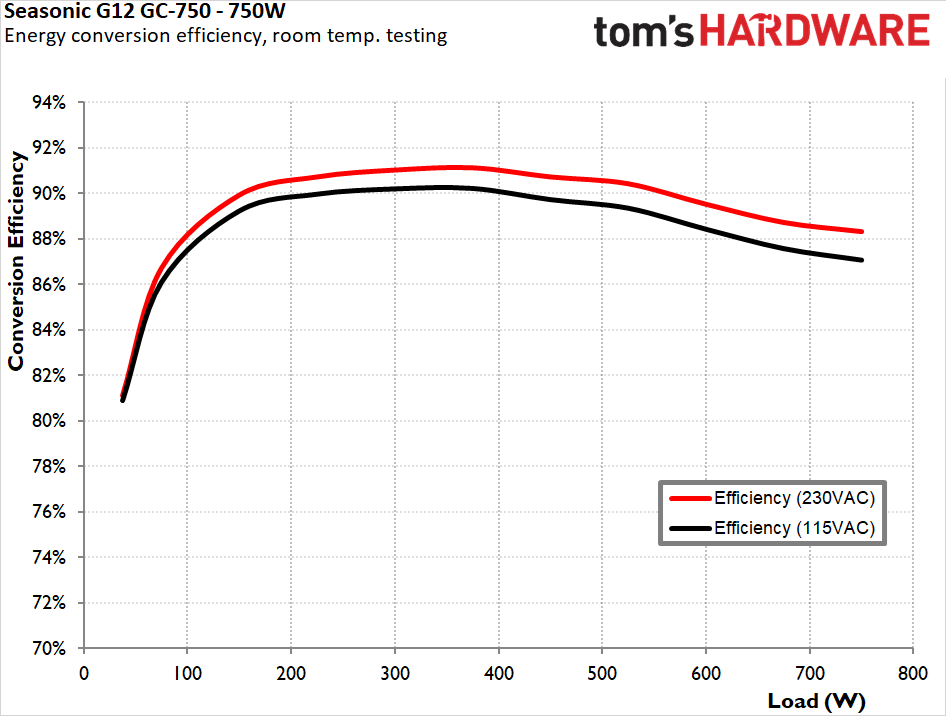

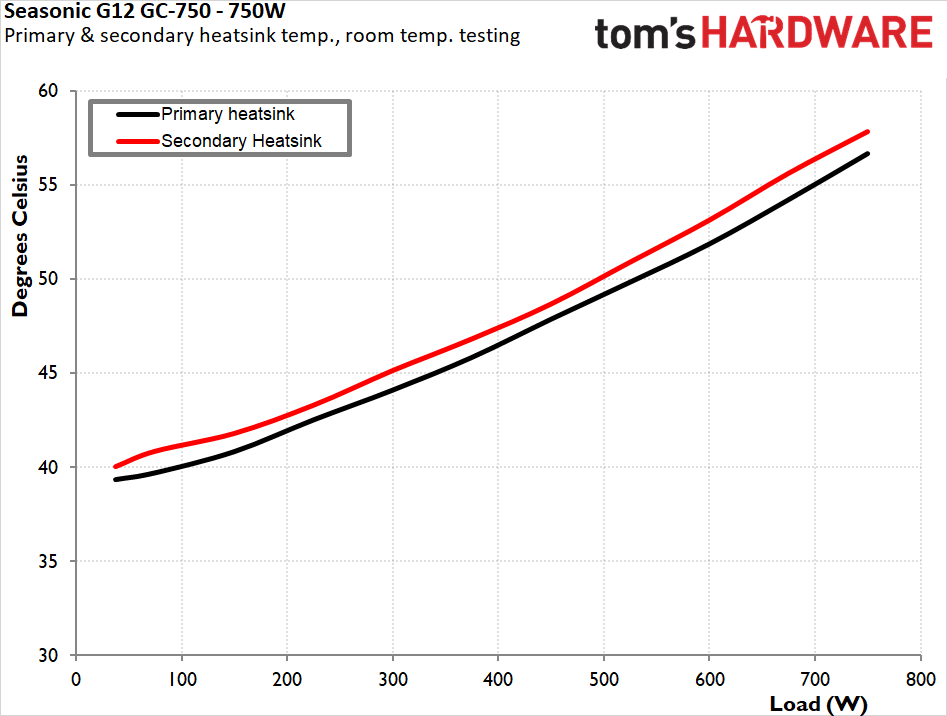
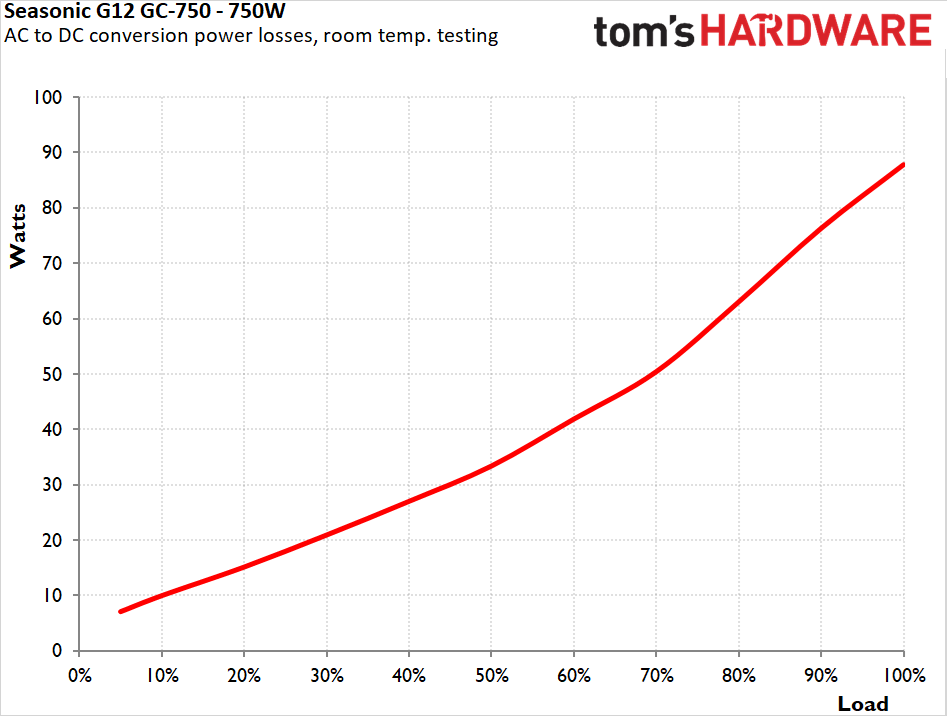
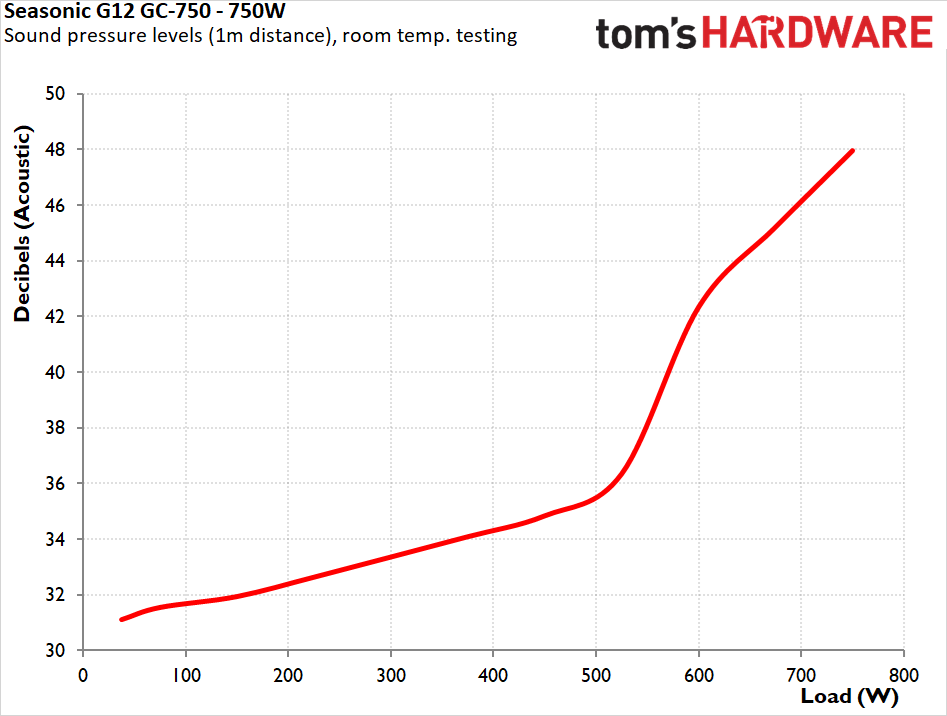
Under controlled cold testing conditions, the Seasonic G12 GC-750 delivered efficiency performance that satisfies its 80 Plus Gold certification requirements. At 115 VAC input voltage, the unit achieved an average nominal load efficiency of 88.8%, while 230 VAC input improved performance to 89.7%. These figures place the unit solidly within Gold certification parameters and represent respectable performance for a mainstream power supply. The efficiency curve exhibits typical behavior, peaking at approximately 50% load. Low load efficiency proves quite good for a unit in this market segment, suggesting that users running basic systems will benefit from acceptable power conversion characteristics even during idle or light usage scenarios.
The fan behavior during cold testing reveals Seasonic's conservative thermal management philosophy. The Hong Hua fan maintains remarkably low rotational speeds across most of the load spectrum, remaining virtually inaudible even at moderate loads. However, the fan profile exhibits a sudden jump in speed once load exceeds 500 watts, creating a noticeable acoustic step rather than a gradual ramp. While this behavior may prove disconcerting for users planning for a quiet build even when it becomes heavily loaded, it reflects Seasonic's prioritization of component longevity over absolute acoustic refinement. Internal temperatures remain very low throughout testing, suggesting that the fan curve provides substantial thermal headroom even when not strictly necessary.
Hot Test Results
Hot Test Results (~45°C Ambient)
Elevated ambient temperature testing reveals the G12 GC-750's remarkable resilience under thermal stress. Contrary to typical mainstream power supply behavior, high ambient temperatures exert almost no detrimental effect on electrical performance. Average nominal load efficiency measures 87.5% at 115 VAC and 88.4% at 230 VAC under hot conditions, a hardly meaningful performance loss. This stability represents exceptional engineering, particularly given that Seasonic rates this unit for full output at 40 °C ambient and 80% output at 50 °C ambient temperature.
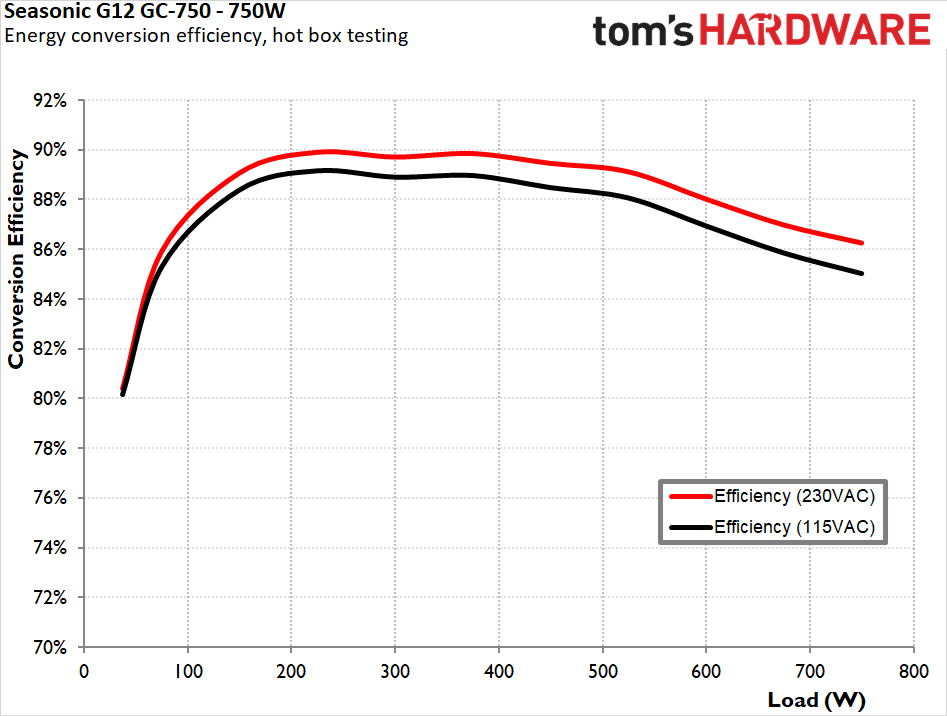
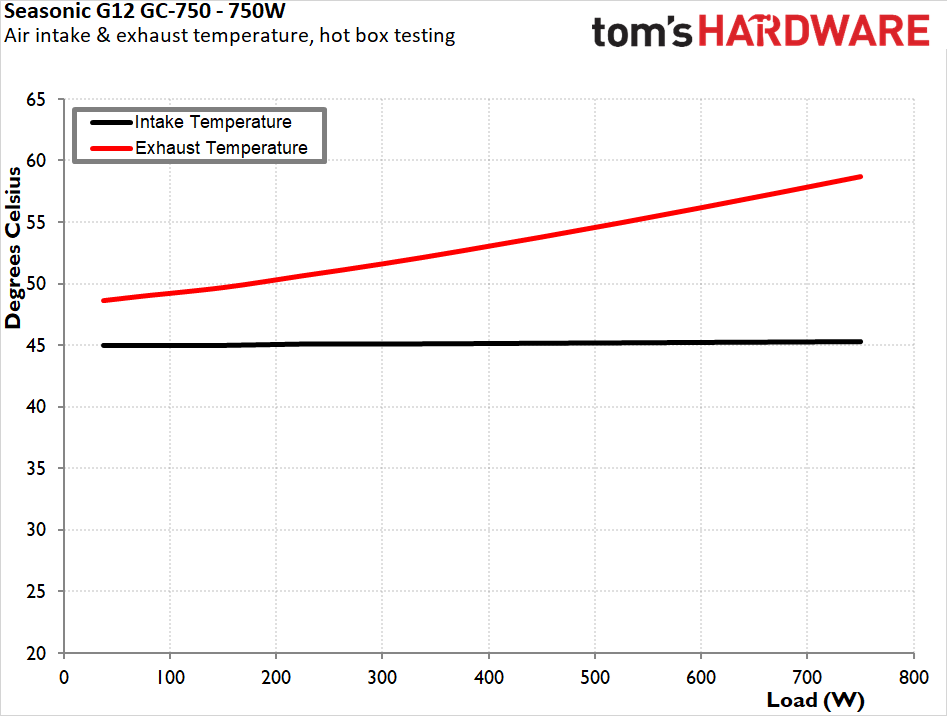
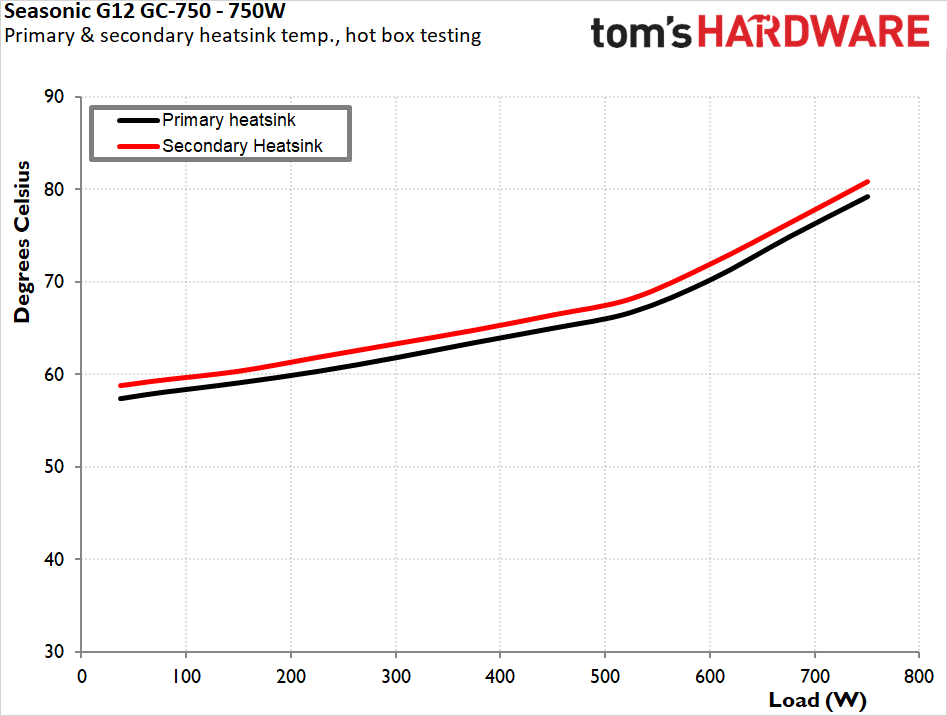
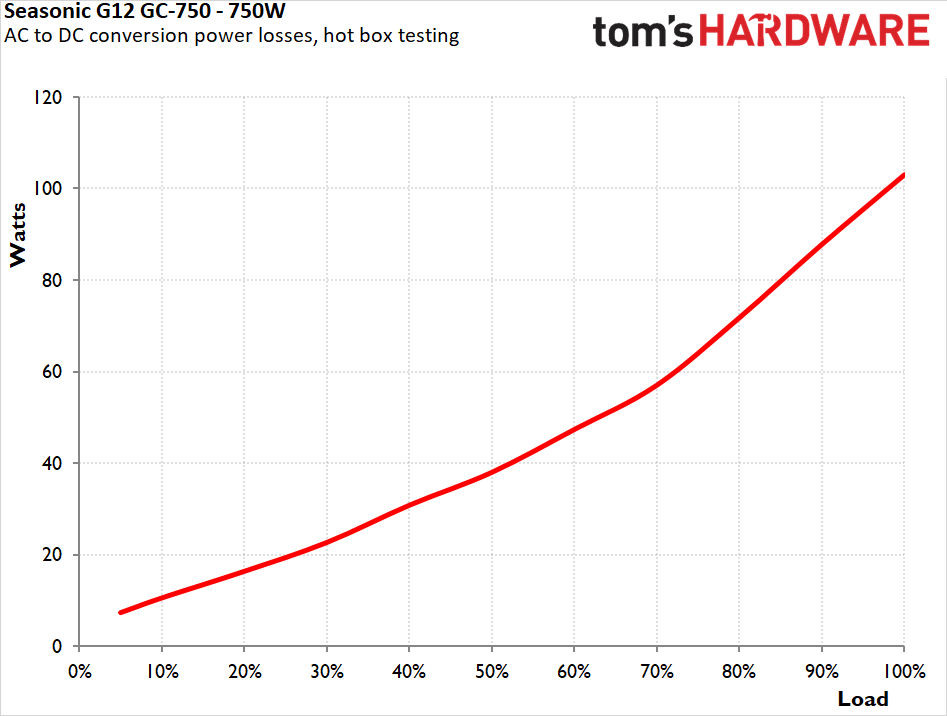
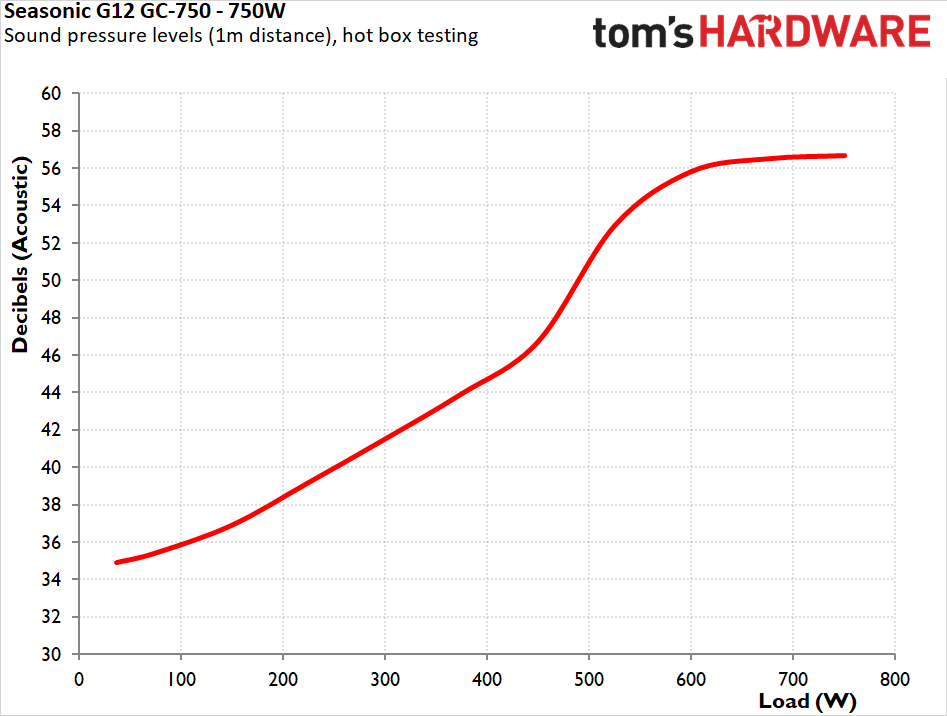
The fan profile under hot conditions reveals the conservative philosophy underlying this unit's thermal management strategy. The steps in the fan curve become considerably wider compared to cold testing, and the fan reaches maximum speed at just 80% load despite internal temperatures remaining quite low throughout testing. This behavior creates significant acoustic impact, as the fan becomes noticeably audible well before the unit approaches its thermal limits. It becomes apparent that the company has aggressively optimized the G12 GC-750 for long-term reliability rather than acoustic comfort. By maintaining substantial thermal margins even under adverse conditions, Seasonic ensures that component temperatures remain conservative, maximizing lifespan at the expense of noise generation. Users in warm climates or poorly ventilated cases will experience increased noise levels during demanding applications, but they can take comfort knowing their power supply operates well within safe thermal parameters.
PSU Quality and Bottom Line
Power Supply Quality
The Seasonic G12 GC-750's electrical performance validates its premium platform heritage, delivering metrics that approach or match far more expensive units. Voltage ripple filtering proves exceptional across all rails, with maximum measurements of just 20 mV on the 12V rail and 14 mV on both the 5V and 3.3V rails. These figures place the G12 GC-750 in elite company, comparable to flagship power supplies costing significantly more. Voltage regulation also achieves near-perfection across all rails. The primary 12V rail maintains an outstanding 0.3% regulation from 20% to 100% load, while the 5V and 3.3V rails achieve 0.6% and 0.5% regulation respectively. These extraordinarily tight specifications exceed typical requirements by substantial margins and ensure that connected components receive stable, clean power regardless of load conditions.
During our thorough assessment, we evaluate the essential protection features of every power supply unit we review, including Over Current Protection (OCP), Over Voltage Protection (OVP), Over Power Protection (OPP), and Short Circuit Protection (SCP). All protection mechanisms were activated and functioned correctly during testing.
Over Current Protection (OCP) triggers at sensible thresholds: 132% on both the 3.3V and 12V rails, and 130% on the 5V rail. These settings provide adequate headroom for transient load spikes while protecting against sustained overcurrent conditions that could damage components or the power supply itself. Over Power Protection (OPP) activates at 130% under hot conditions. The unit handles very short temporary power bursts approaching 1000 watts. This transient power handling capability proves valuable for modern systems with components that exhibit brief power spikes, such as graphics cards during load transitions.
Load (Watts) | 150.84 W | Header Cell - Column 2 | 376.59 W | Header Cell - Column 4 | 564.07 W | Header Cell - Column 6 | 751.420W | Header Cell - Column 8 |
|---|---|---|---|---|---|---|---|---|
Load (Percent) | 20.11% | Row 0 - Cell 2 | 50.21% | Row 0 - Cell 4 | 75.12% | Row 0 - Cell 6 | 100.19% | Row 0 - Cell 8 |
| Row 1 - Cell 0 | Amperes | Volts | Amperes | Volts | Amperes | Volts | Amperes | Volts |
3.3 V | 1.81 | 3.35 | 4.53 | 3.34 | 6.8 | 3.34 | 9.07 | 3.33 |
5 V | 1.81 | 5.09 | 4.53 | 5.08 | 6.8 | 5.07 | 9.07 | 5.06 |
12 V | 11.25 | 12.05 | 28.11 | 12.04 | 42.17 | 12.01 | 56.23 | 12.01 |
Line | Regulation (20% to 100% load) | Voltage Ripple (mV) | Header Cell - Column 3 | Header Cell - Column 4 | Header Cell - Column 5 | Header Cell - Column 6 | Header Cell - Column 7 |
|---|---|---|---|---|---|---|---|
| Row 0 - Cell 0 | Row 0 - Cell 1 | 20% Load | 50% Load | 75% Load | 100% Load | CL1 12V | CL2 3.3V + 5V |
3.3V | 0.5% | 6 | 12 | 14 | 10 | 10 | 16 |
5V | 0.6% | 8 | 12 | 14 | 8 | 12 | 16 |
12V | 0.3% | 10 | 6 | 20 | 18 | 12 | 14 |
Bottom Line
The Seasonic G12 GC-750 exists as a study in contradictions - a power supply where exceptional internal engineering confronts pragmatic market realities. From a purely technical perspective, this unit performs magnificently. The electrical characteristics rival units costing twice as much, the component selection demonstrates Seasonic's commitment to quality even in supposedly budget-focused products, and the proven platform heritage promises long-term reliability that cheaper alternatives cannot match. This truly is a wolf in sheep's clothing, with top-tier performance hidden beneath a conservative exterior and budget-segment positioning.
However, power supplies compete in markets where technical excellence represents only one dimension of value. The completely non-modular cable design, while potentially defensible as a cost-reduction measure that could enable better component investment, becomes difficult to justify when the retail price regularly exceeds $140. At this price point, competitors offer modular connectivity as a standard feature, and Seasonic's own product line includes semi-modular alternatives like the G12 GM series. The non-modular design might appeal to builders who prioritize internal quality over cable management convenience and aesthetics but the pricing undermines this value proposition significantly. The absence of a 12V-2x6 connector represents a more fundamental limitation, immediately restricting compatibility with newer graphics cards. Given the unit's 750W capacity and demonstrated ability to handle power bursts approaching 1000W, this omission appears to stem from platform age rather than technical limitations. For builders planning system longevity, this missing connector could necessitate premature power supply replacement as graphics card requirements evolve.
Yet these criticisms must be contextualized by market realities: the G12 GC-750 frequently appears on sale for less than $80 or €70, transforming its value proposition entirely. At these promotional prices, the technical excellence and component quality become genuine advantages rather than footnotes to an overpriced product. A builder acquiring this unit on sale receives electrical performance and reliability typically reserved for units costing $150 or more, with the only compromises being cable management convenience and modern connectivity that may not matter for current-generation systems. For builders assembling systems intended for multi-year service lives, particularly those using graphics cards that do not require PCIe 5.0 power connectors, the G12 GC-750 on sale represents an outstanding choice. The exceptional power quality ensures stability and longevity for sensitive components, the conservative thermal management promises longevity in challenging environments, and the top-tier electrical performance eliminates power delivery as a potential system bottleneck. The non-modular cables become a minor inconvenience rather than a deal-breaker in this context.
However, at full retail price, the G12 GC-750 struggles to justify its premium. Builders paying $140+ would be better served by competitors offering modular designs, contemporary connectivity, and longer warranties even if internal electrical performance proves slightly inferior. The technical excellence, while genuinely impressive, cannot overcome market realities when similar money purchases more well-rounded products. The Seasonic G12 GC-750 ultimately succeeds brilliantly in its intended role as a sale-priced powerhouse for reliability-focused builders, while struggling at MSRP against feature-rich alternatives. For those fortunate enough to acquire it at promotional pricing, this represents one of the best values in the PSU market, proof that Seasonic's engineering excellence can create compelling products even when compromised by positioning decisions. For those paying full retail: shop around.
MORE: Best Power Supplies
MORE: How We Test Power Supplies
MORE: All Power Supply Content

Dr. E. Fylladitakis has been passionate about PCs since the 8088 era, beginning his PC gaming journey with classics like Metal Mutant and Battle Chess. Not long after, he built his first PC, a 486, and has been an enthusiast ever since. In the early 2000’s, he delved deeply into overclocking Duron and Pentium 4 processors, liquid cooling, and phase-change cooling technologies. While he has an extensive and broad engineering education, Dr. Fylladitakis specializes in electrical and energy engineering, with numerous articles published in scientific journals, some contributing to novel cooling technologies and power electronics. He has been a hardware reviewer at AnandTech for nearly a decade. Outside of his professional pursuits, he enjoys immersing himself in a good philosophy book and unwinding through PC games.
-
Cervisia ReplyThe G12 GC-750 enters this challenging landscape …
It entered the market in 2021, and that was a different landscape without ATX 3.x.
Why is it reviewed now? Did it suddenly show up on the US market?
Seasonic … designs, engineers, and produces its own units rather than relying on third-party ODMs.
For the G12 GC/GM, Seasonic relies on Helly Technology.
